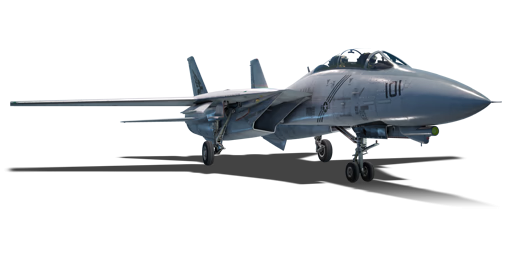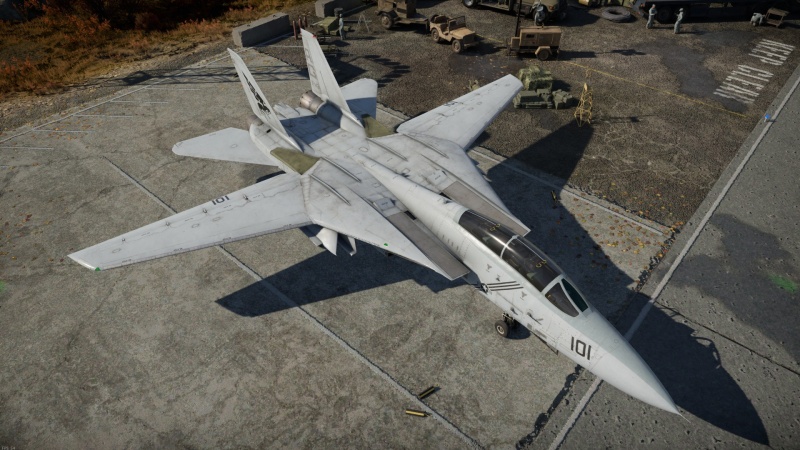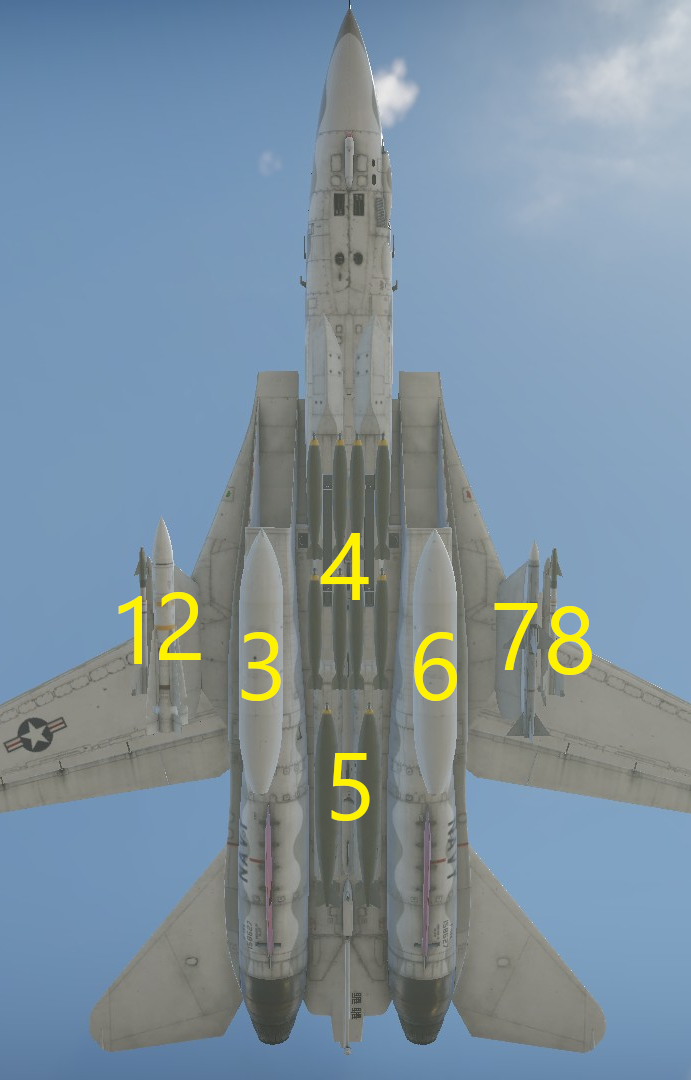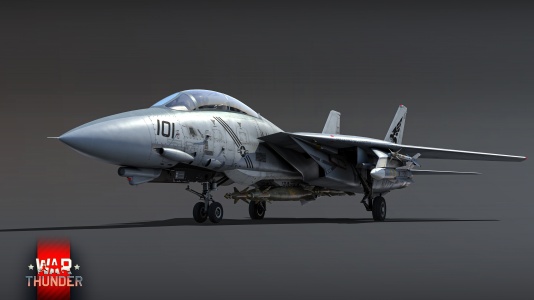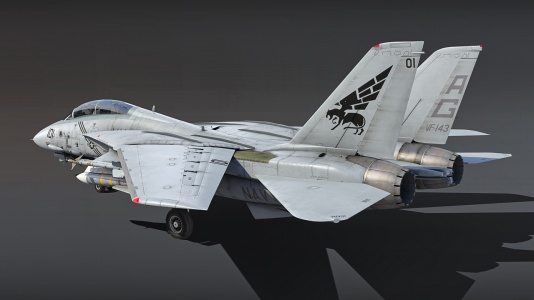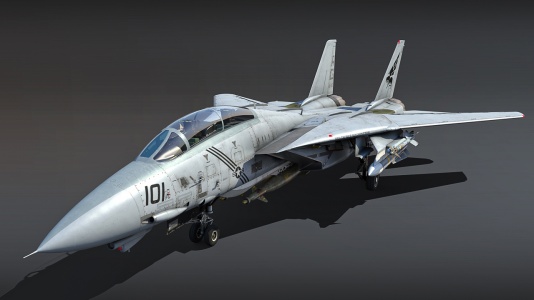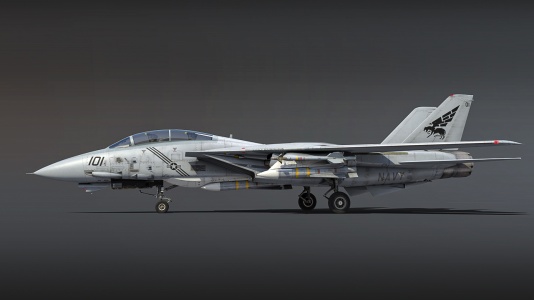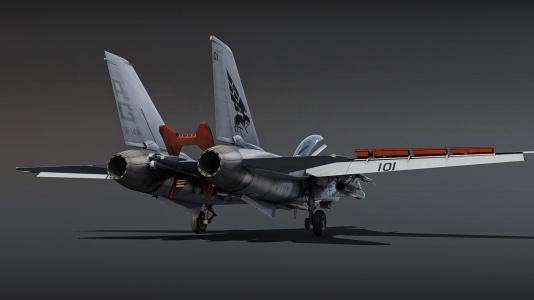Difference between revisions of "F-14B"
(Tag: Visual edit) |
(Updated description to new format) |
||
| Line 11: | Line 11: | ||
== Description == | == Description == | ||
<!-- ''In the description, the first part should be about the history of and the creation and combat usage of the aircraft, as well as its key features. In the second part, tell the reader about the aircraft in the game. Insert a screenshot of the vehicle, so that if the novice player does not remember the vehicle by name, he will immediately understand what kind of vehicle the article is talking about.'' --> | <!-- ''In the description, the first part should be about the history of and the creation and combat usage of the aircraft, as well as its key features. In the second part, tell the reader about the aircraft in the game. Insert a screenshot of the vehicle, so that if the novice player does not remember the vehicle by name, he will immediately understand what kind of vehicle the article is talking about.'' --> | ||
| − | |||
| + | Even before the F-14 had its first test flight, Grumann knew the F-14A's performance would be underwhelming due to its TF-30 engines. This, as well as the VAX-2 specification sent out by the US Navy during the 1980s, led to the F-14B. The F-14B was a huge improvement over the F-14A in almost every aspect. New avionics, systems, engines, and much more were done on the F-14B. One of the upgrades included the addition of the AN/AXX-1 Television Camera System" (TCS), for IFF purposes. The F-14B's main upgrade were the engines; General Electric F110-GE-400s replaced the TF-30s and massively improved the performance in essentially every aspect. The range, top speed, and turn rate were significantly improved, which meant the F-14B was far more suitable for carrier operations than the F-14A. | ||
| + | |||
| + | Introduced in [[Update "La Royale"]], the '''{{Specs|name}}''' is an extremely capable aircraft. The F-14B is essentially a heavily upgraded [[F-14A Early|F-14A]]. With new engines, avionics, and weapons, the F-14B is a much more potent aircraft. It gets access to [[AIM-9L Sidewinder|AIM-9L Sidewinders]], [[AIM-7M Sparrow|AIM-7M Sparrows]], and [[AIM-54C Phoenix|AIM-54C Phoenixes]], which is a big improvement over the F-14A's armament. Furthermore, the General Electric engines make the F-14B far more competent in dogfights compared to the F-14A. The F-14B is also more capable for ground attack thanks to the addition of the Paveway II guided bomb. | ||
== General info == | == General info == | ||
=== Flight performance === | === Flight performance === | ||
Revision as of 05:51, 21 October 2023
| This page is about the American jet fighter F-14B. For the other version, see F-14A Early. |
Contents
Description
Even before the F-14 had its first test flight, Grumann knew the F-14A's performance would be underwhelming due to its TF-30 engines. This, as well as the VAX-2 specification sent out by the US Navy during the 1980s, led to the F-14B. The F-14B was a huge improvement over the F-14A in almost every aspect. New avionics, systems, engines, and much more were done on the F-14B. One of the upgrades included the addition of the AN/AXX-1 Television Camera System" (TCS), for IFF purposes. The F-14B's main upgrade were the engines; General Electric F110-GE-400s replaced the TF-30s and massively improved the performance in essentially every aspect. The range, top speed, and turn rate were significantly improved, which meant the F-14B was far more suitable for carrier operations than the F-14A.
Introduced in Update "La Royale", the F-14B Tomcat is an extremely capable aircraft. The F-14B is essentially a heavily upgraded F-14A. With new engines, avionics, and weapons, the F-14B is a much more potent aircraft. It gets access to AIM-9L Sidewinders, AIM-7M Sparrows, and AIM-54C Phoenixes, which is a big improvement over the F-14A's armament. Furthermore, the General Electric engines make the F-14B far more competent in dogfights compared to the F-14A. The F-14B is also more capable for ground attack thanks to the addition of the Paveway II guided bomb.
General info
Flight performance
Describe how the aircraft behaves in the air. Speed, manoeuvrability, acceleration and allowable loads - these are the most important characteristics of the vehicle.
| Characteristics | Max speed (km/h at 10,668 m) |
Max altitude (metres) |
Turn time (seconds) |
Rate of climb (metres/second) |
Take-off run (metres) | |||
|---|---|---|---|---|---|---|---|---|
| AB | RB | AB | RB | AB | RB | |||
| Stock | 2,191 | 2,181 | 16764 | 24.4 | 24.5 | 195.5 | 188.7 | 750 |
| Upgraded | 2,238 | 2,215 | 23.6 | 24.0 | 256.6 | 224.8 | ||
Details
| Features | |||||
|---|---|---|---|---|---|
| Combat flaps | Take-off flaps | Landing flaps | Air brakes | Arrestor gear | Drogue chute |
| ✓ | ✓ | ✓ | ✓ | ✓ | X |
| Limits | Wings (km/h) | Gear (km/h) | Flaps (km/h) | Max Static G | |||
|---|---|---|---|---|---|---|---|
| Combat | Take-off | Landing | + | - | |||
| Min sweep | 1,359 | 518 | 1,200 | 873 | 416 | ~10 | ~5 |
| Max sweep | 1,555 | ~11 | ~5 | ||||
| Optimal velocities (km/h) | |||
|---|---|---|---|
| Ailerons | Rudder | Elevators | Radiator |
| < 1,200 | < 850 | < 1,800 | N/A |
Engine performance
| Engine | Aircraft mass | ||||||||
|---|---|---|---|---|---|---|---|---|---|
| Engine name | Number | Basic mass | Wing loading (full fuel) | ||||||
| General Electric F110-GE-400 | 2 | 19,663 kg | 514 kg/m2 | ||||||
| Engine characteristics | Mass with fuel (no weapons load) | Max Gross Weight | |||||||
| Weight (each) | Type | 16m fuel | 20m fuel | 30m fuel | 45m fuel | 53m fuel | |||
| 1,897 kg | Afterburning low-bypass turbofan | 21,868 kg | 22,399 kg | 23,766 kg | 25,818 kg | 27,013 kg | 33,593 kg | ||
| Maximum engine thrust @ 0 m (RB/SB) | Thrust to weight ratio @ 0 m (WEP) | ||||||||
| Condition | 100% | WEP | 16m fuel | 20m fuel | 30m fuel | 45m fuel | 53m fuel | MGW | |
| Stationary | 6,200 kgf | 10,230 kgf | 0.93 | 0.91 | 0.86 | 0.79 | 0.76 | 0.61 | |
| Optimal | 6,428 kgf (1,200 km/h) |
13,610 kgf (1,200 km/h) |
1.24 | 1.22 | 1.15 | 1.05 | 1.00 | 0.81 | |
Survivability and armour
Examine the survivability of the aircraft. Note how vulnerable the structure is and how secure the pilot is, whether the fuel tanks are armoured, etc. Describe the armour, if there is any, and also mention the vulnerability of other critical aircraft systems.
Modifications and economy
Armaments
| Ballistic Computer | ||||
|---|---|---|---|---|
| CCIP (Guns) | CCIP (Rockets) | CCIP (Bombs) | CCRP (Bombs) | Lead indicator |
| |
|
|
|
|
Offensive armament
The F-14B is armed with:
- 1 x 20 mm M61A1 cannon, cheek-mounted (676 rpg)
- 60 x countermeasures
Suspended armament
The F-14B can be outfitted with the following ordnance:
| 1 | 2 | 3 | 4 | 5 | 6 | ||
|---|---|---|---|---|---|---|---|
| 500 lb LDGP Mk 82 bombs | 8¶ | 6 | |||||
| 500 lb Mk 82 AIR bombs | 8¶ | 6 | |||||
| 1,000 lb LDGP Mk 83 bombs | 2¶ | 2 | |||||
| 1,000 lb Mk 83 AIR bombs | 2¶ | 2 | |||||
| 2,000 lb LDGP Mk 84 bombs | 2¶ | 2 | |||||
| 2,000 lb LDGP Mk 84 Air bombs | 2¶ | 2 | |||||
| 957 kg GBU-10 Paveway II bombs | 2†‡¶ | ||||||
| 277 kg GBU-12 Paveway II bombs | 2† | † | |||||
| 1,092 lb GBU-16 Paveway II bombs | 2† | 2† | |||||
| 2,000 lb GBU-24 Paveway III bombs | 1†‡¶ | 1† | |||||
| Zuni Mk32 Mod 0 ATAP rockets | 8 | 8 | |||||
| AIM-7M Sparrow missiles | 1 | 2 | 1‡, 2¶ | 1 | |||
| AIM-9L Sidewinder missiles | 1* | 1* | 1* | 1* | |||
| AIM-54A Phoenix missiles | 1 | 2¶ | 2 | 1 | |||
| AIM-54C Phoenix missiles | 1 | 2¶ | 2 | 1 | |||
| Countermeasures | 160* | 160* | 160* | 160* | |||
| LANTIRN targeting pod | 1† | ||||||
| * AIM-9L missiles can be equipped with countermeasures on the same hardpoint †LANTIRN targeting pod must be equipped when carrying guided bombs ‡Single AIM-7M missile on hardpoint 4 cannot be equipped with GBU-10 or GBU-24 bombs on hardpoint 3 ¶ Dual AIM-7M missiles on hardpoint 4 cannot be equipped with marked options on hardpoint 3 | |||||||
| Default weapon presets | |
|---|---|
| |
Usage in battles
Air Realistic Battles
Dogfighting
The F-14 may have been built as a large, missile carrying interceptor, but do not be fooled; the F-14B is also a supremely capable dogfighter which, if flown correctly, can out-manoeuvre nearly every fighter in the game. However, this is much easier said than done. The plane itself will not do all the work; proper tactics, energy management, and utilization of the F-14's flaps and variable sweep wings are required to get this fighter to perform in a dogfight.
Flaps
Usage of the F-14B's flaps is critical in dogfights. With the flaps completely up, the F-14B can attain higher speeds outside of dogfights, though at this flap state the plane will not be at its full manoeuvring potential. Generally, during dogfights, it is preferable to set the flaps to "combat", as this significantly boosts both F-14B's instantaneous and sustained turn rates. Energy retention at this flap state, while lowered, is still sufficient, and the combination of turn and energy retention will make this flap state ideal for two-circle rate fights. The combat flaps can be extended at very high speeds, and thus pilots should not be worried about them falling off. In some cases, the flaps can be brought back up to increase energy retention and gain back energy. Setting the flaps to "takeoff" will further increase manoeuvrability at the expense of additional energy retention. The "landing" flaps gives the F-14B its fastest turn rate and tightest turning circle, but at the expense of greatly diminished energy retention. These flaps should be used at lower speeds, ideally in one-circle fights or if you are behind the enemy. It should be noted that in the "landing" configuration, the flaps have a much lower speed tolerance than the other configurations. Go above 400 km/h with these flaps down, and you risk breaking them off, so be careful.
If it wasn't clear already, it is important to keep these flaps on, as if you do lose your flaps, you will greatly damage your dogfighting capability, not to mention the loss of dogfighting position that comes from the force of the flaps breaking off. If you've lost your flaps but sense you will eventually have to dogfight the enemy, it is best to go back to your airfield to get them repaired. If you end up locked in a dogfight without flaps, your best bet would be to keep your speed up and attempt a two-circle rate fight. Without it's flaps, the F-14B's AOA (angle of attack) is not sufficient for one circle fights, so in most cases, do not attempt them.
The Two-Circle (Rate Fight)
The F-14B's main advantage in a dogfight is its excellent energy retention and sustained turn rate. These can be used to great extent in a two-circle rate fight, which will be the preferred type of fight for the F-14B. Due to this, it is important that F-14 pilots understand this rate fight. A two-circle rate fight is a type of dogfight where the two fighters attempt to get on each other's tails. In this kind of dogfight, instead of turning as hard as you can, you instead must keep a certain speed. All fighter jets lose speed in turns, and generally, they turn worse at lower speeds. A fighter jet's optimal rate speed is the speed at which they can sustain the highest turn rate (or, the sustained turn rate). While you could pull harder to turn faster, you would be sacrificing speed to do this, and if you cannot take the shot, you will get slow and lose your turning capability, eventually lagging behind the now better turning enemy fighter. All aircraft have different flight capabilities and varied sustained turn rates. In a rate fight, the aircraft with the better sustained turn rate will have the advantage.
The beginning of the fight will have the two fighters' paths form two circles, hence the name. The fighter with the superior sustained turn rate (which we'll call the friendly fighter) will attempt to manoeuvre onto the other enemy fighter's tail. While this is happening, they must carefully manage their energy, taking great care in ensuring they do not go too much faster or slower than their optimal rate speed. During this initial turn, the enemy fighter may turn harder and initially get a shot on the friendly fighter, who must dodge. As the two fighters turn, the enemy fighter with the inferior sustained turn rate will lose speed faster, forcing them to fly downwards to use gravity to gain more speed and thus more turn, and the friendly fighter will follow. Eventually, the fight will lower to the ground, where there won't be any more altitude for the enemy fighter to gain speed. With the enemy fighter now slow, the friendly fighter, still fast and better turning, will begin to get behind the other fighter (the enemy fighter is being "out-rated" here). Once they are approaching the enemy's tail, the enemy fighter may attempt to get the friendly fighter to overshoot by turning hard; to counteract this, the friendly fighter can pull hard, drop the flaps further, and/or airbrake to stay on the enemy's tail. At this point, the friendly fighter will be firmly planted on the tail of the enemy and has an opportunity to shoot them down.
Some jets will prefer the two-circle, while others will prefer other tactics. Again, the F-14B is one that favours this two-circle type of fight; in fact, theoretically, the F-14B has a superior sustained turn rate to just about every single aircraft it will encounter at top tier, with one notable exception in the F-16. In the F-14B, the optimal rate speed can be achieved around 800-830km/h with full afterburner, the wings at 0% sweep and combat flaps down. For maximum turn rate, it is imperative that you stay around this speed. To do this, you can tap your elevator key, or use the mouse to gradually turn. It is fine if it gets below that speed but be sure to regain it eventually. Try not to go below 700km/h, as by that point, the turn rate will start to noticeably suffer. Above 830km/h, you will want to drop down back to your optimal rate speed by turning harder, but when doing this sweep the wings back a little (to around 20-30%), as this will help you lose speed and allow you to turn harder without breaking the wings off (at 0% wing sweep, you risk ripping the wing off at these higher speeds). When entering a dogfight in the F-14B, it is preferable to be at a higher speed (>900 km/h). This way, when you merge with an enemy fighter, you can sweep the wings back to around 45% and deploy combat flaps to boost your initial turn rate, thus initially gaining position before sweeping your wings forward and reaching your optimal rate speed.
The One-Circle and Counter-Two Circle Tactics
The other type of dogfight is the one-circle fight. This one is generally simpler than the two circle. It involves both fighters turning as hard as they can into each other. Unlike a two-circle fight, where the fighters turn opposite of each other to get on each other’s tails, a one-circle fight sees the two fighters turning directly into each other. In one-circle dogfights, sustained turn rate is irrelevant, as the fight will come down to which aircraft can turn better in a short amount of time. Speed is not as important in these fights; actually, depending on how the one-circle dogfight develops, it is often advantageous to keep speed low so that the faster enemy aircraft will pass out in front. Due to this, most one-circle fights often occur at low speeds.
Fighters which prefer one-circle tactics are those which can turn tightly (or instantaneous turn rate), have a high AOA (Angle of Attack) and have a low stall speed. One circle fighters often are superior turners at lower speeds. Typically, planes which have excellent instantaneous turn rate have the downside of trading off energy retention and sustained turn rate. Therefore, fighters which prefer the two-circle will want to rate fight these one-circle fighters.
However, in practice, this is much easier said than done. When quickly transitioning from the chaotic and fast-paced nature of Air RB combat to a dogfight, there usually isn’t a lot of time to think, so it may not be easy to set up the conditions for a rate fight in such a short amount of time. This is especially true for the F-14; while the multiple flap, wing sweep and radar states give F-14 pilots numerous options for combat, quickly and manually reconfiguring all these parts for a rate fight can prove challenging. It doesn’t help that the F-14B’s rate speed is rather high at 800km/h, so if the F-14 stars the dogfight slow, it is already at a disadvantage.
Once again, it is important for pilots in two-circle fighters to remember not to panic and keep their speed at their optimal rate speed. Because in rate fights, this is exactly what one-circle fighters attempt to exploit to gain the advantage. It is sort of a mental game, where they attempt to trick you into pulling hard and losing your speed, thus drawing you into the one-circle fight where you will subsequently be destroyed. There are numerous tactics for this. When rating, they may pull into you, cashing in their speed in an attempt to make you panic, pull hard and lose your speed. In a horizontal rate, they may pull downwards to gain speed and pull up into you; when this happens, pull up and sideways perpendicular to them, in order to say out of their guns while keeping your speed.
One of the more effective tactics is actually performed when the two-circle fighter is on the verge of winning. Like earlier, we’ll call the two-circle Fighter the friendly aircraft and the one-circle fighter the enemy aircraft. When the two aircraft are close to the ground, the friendly fighter will out-rate the enemy. It is when the friendly fighter is gaining on the enemy, but is not fully around the circle yet, that the enemy fighter begins to pull a bit harder, suggesting they are slow and vulnerable. Seeing this, and on the verge of wining, the friendly fighter may choose to finish the fight now, cashing in their speed to turn hard and shoot the enemy while they are vulnerable. But, this is a trick. The enemy still has some speed left, and because the friendly fighter wasn’t fully around the circle yet, they had insufficient speed to complete the turn and get the shot on the enemy. This results in the friendly fighter now being slow, and the enemy fighter can take this opportunity to close the distance with the friendly fighter and turn it in to a one-circle fight. At this point, it is likely game-over for the friendly fighter. Additionally, this scenario could also happen if the friendly fighter started pulling hard too early, and ran out of speed before they could take the shot. Ideally, the friendly fighter would have ignored the enemy’s hard pull, instead continuing with the rate until they are actually close enough to reliably hit the shot. This way, even if the friendly fighter missed their shot, they would have enough speed to continue rating.
As for the F-14B, it is not as much of a one-circle fighter as it is a two-circle fighter, but it still performs very well in the one-circle. At the very least, combat flaps should be utilized when in any kind of dogfight. The slower you get, the more you can lower your flaps; set it to “takeoff” from 600-400km/h, and below 400km/h, to “Landing”. Landing flaps provides the most lift and turn and therefore should always be used when dogfighting at lower speeds.
If necessary, you may set a key bind to switch to the “realistic” or “full-real” control mode. In the F-14B, it allows for much higher angles of attack and higher low-speed control. However, keep in mind that with realistic/full-real, maneuvering harder at lower speeds will bleed speed very quickly. Additionally, depending on the maneuver, one could easily destabilize the aircraft, which would typically mean game-over in a one circle fight. Therefore, use advanced controls sparingly if at all.
Though the F-14B is good in the one-circle, getting locked into a one-circle fight with a dedicated one-circle fighter such as the MiG-29, Mirage 2000 or JA37 will very quickly result in a loss for the F-14. Stick to the two-circle if possible
Radar Lead Indicator
The F-14 comes equipped with a radar lead indicator, which calculates the lead required to hit a moving aircraft. At higher speeds, this mechanic can be a bit finicky, but at slower speed dogfights, it is much more accurate. The radar lead indicator can be quite helpful in dogfights, especially when the difference between victory and defeat could come down to hitting a single gunshot opportunity. In the F-14, the best way to get this to work is by using the radar's ACM (Acquisition Mode) to automatically radar lock the enemy aircraft once in range. It is important that, in dogfights, the radar is set to the standard SRC mode. The radar's other pulse-Doppler modes, while highly useful in general combat, are highly unreliable in dogfights, as it is prone to losing lock in tail-chase and side-aspect radar locks- both situations you will constantly encounter in dogfights. The normal SRC mode does not have these limitations, and at the close ranges dogfights occur at, ground clutter and chaff will usually not be an issue. To further optimize the radar lead indicator, you can switch the ACM mode on, and then press "change radar mode" to change the small box to a tall rectangle; this can be used to automatically radar lock an aircraft without directly pointing towards them (the shape of this box will usually catch aircraft you are about to take a gunshot at).
Aircraft Worth Noting
While the F-14B itself is a highly capable dogfighter, so are many of the common enemies that it will face. In order to prevail, you need to know the strengths and weaknesses of both your own and the opposing aircraft you will be facing.
- F-16A (All): The F-14B is nearly unmatched in a rate fight. Unfortunately, arguably the most common fighter family at top tier- the supremely capable F-16A and its variants- are also the only aircraft superior to the F-14B in a rate fight. Even in the one-circle, the F-16A seems to have a slight advantage. Therefore, if possible, it is best to avoid dogfights with F-16As. Keep in mind that the F-16A being a superior aircraft has nothing to do with its pilot's skill; in a dogfight, if you recognize that an enemy F-16A is pulling too hard and getting too slow, keeping your optimal rate speed will allow you to emerge victorious in a two-circle rate fight.
- F-16C: Sporting more engine power than the previous F-16A, formidable AIM-7M Sparrows and extremely dangerous AIM-9Ms paired with a HMD, this fighter is a force to be reckoned with. In a dogfight, like the previous A variant it is extremely capable. However, despite the extra engine power given from the improved engine, the added weight of other avionics actually makes it a slightly worse dogfighter than the previous F-16A. While the F-16C is still very dangerous in a one-circle against the F-14B, the slight decrease in dogfighting performance allows the F-14B to keep up with the F-16C in a two-circle fight.
- MiG-29A: The MiG-29A is highly capable in the one-circle fight, having a better AOA and tighter turn radius than the F-14B. However, it does also have worse energy retention; thus, as long as you can keep the MiG-29A in a two-circle fight, the F-14B will be able to prevail.
- MiG-29SMT: The MiG-29SMT is a heavier MiG-29A, so it can be out-rated easier than the MiG-29A. However, keep in mind that the SMT has extremely dangerous R-73s paired with a HMD, so be sure to start pre-flaring if you notice you may be about to be launched on.
- Mirage 2000C, Mirage 2000-5F: The Mirage 2000s are among the tightest and fastest turning fighters in the game. Therefore, in the F-14B, it is highly advised not to attempt engaging them in two-circle fights, as in nearly all situations this will end in your defeat. As a delta-winged fighter, the Mirage 2Ks lose lots of speed in a turn. This makes the two-circle rate fight the F-14B is so good at the main strategy when dogfighting Mirage 2Ks. Against Mirages, it is important to recognize their energy state; even if it seems like the Mirage is getting behind you, it could be that, in reality, they are slow and only sitting inside your circle, unable to shoot you. Stay calm and do your best to stay at the F-14B's optimal rate speed of 800km/h. Try not to panic and pull too hard to get away from the Mirage's nose, as doing so will slow you down and make the Mirage's victory come closer. Continue to rate until you reach the ground, where you will begin outrating them. Remember that the 2000-5F has a HMD, making the Magic 2 missiles a problem in dogfights.
- F-14A (Early): The earlier F-14A is very similar in dogfighting performance to the F-14B, with similar turn and rate performance. The F-14B does have superior engine power over the F-14A, so make sure to utilize the vertical to gain an advantage against this older F-14.
- MiG-23 (All): MiG-23s are, like the F-14B, excellent rate fighters. However, the F-14B's sustained turn rate is slightly better than the MiG-23's. An easier tactic is to one-circle them, as the F-14B has a much superior instantaneous turn rate.
- Viggens (JA37C, JA37D, AJ37, AJS37): The Viggen has an excellent instantaneous turn rate. However, its energy retention is very poor, and thus two-circle rate tactics should be used to overcome this Swedish fighter in a dogfight.
Pros and cons
Pros:
- Ability to equip additional countermeasure pods grants a massive amount of countermeasures
- Access to upgraded AIM-7M SARH missiles and AIM-54C ARH missiles
- All-aspect AIM-9L Sidewinder missiles are a significant upgrade from the previous rear-aspect AIM-9H
- High velocity and extremely fast firing M61 rotary cannon
- Large air-to-air missile capacity of eight
- Substantial improvement to thrust and climb rate from the previous F-14A
- Same powerful radar as the previous F-14A
- Strong air-to-ground load out with Paveway laser-guided bombs and the LANTIRN thermal laser targeting pod
- Great instantaneous turn rate and excellent sustained turn rate
- Excellent energy retention
- Built-in camera targeting system automatically zooms in to radar locked aircraft and is useful for identification in simulator mode
- Built-in camera works with the EEGS, allowing you to use the function by applying the target point on the enemy
Cons:
- Large airframe makes for a large target
- Two very hot engines make it harder to flare off IR-guided missiles
- M61 rotary cannon has a rather small ammunition pool of 676
- The AIM-54C still only has 17G maximum overload and is thus rather easy to kinetically defeat
History
F-14B Upgrade Program
During the mid-1980s, the United States Navy (USN) made a momentous decision to enhance the F-14 airframe by introducing a remarkable new variant of the aircraft. Originally designated as the F-14A+, this exceptional aircraft would eventually earn the prestigious moniker of the F-14B. The USN's comprehensive modernization program aimed to bring the F-14 airframe up to date with the latest technological advancements. One of the key aspects of this program was the incorporation of numerous electronic upgrades. The F-14B underwent a significant avionics overhaul, introducing advanced systems that improved the aircraft's capabilities in various areas. These upgrades included enhanced RWR systems, improved target detection and tracking capabilities (introduction of the Television Camera System) and upgraded communication systems to ensure seamless integration with other elements of the modern battlefield. In addition to these upgrades, the F-14B also received a major boost in terms of its powerplant. The outdated engines of the original F-14A model were replaced with the more advanced F110-GE-400 engines. These engines provided increased thrust and improved fuel efficiency, resulting in enhanced performance and greater operational flexibility for the aircraft. The F-110 engines also offered improved reliability and reduced maintenance requirements, which were crucial factors in ensuring the overall effectiveness and availability of the F-14B.
Devblog
As part of the further upgrade of the Grumman F-14A carrier-based fighters, the aircraft were equipped with new General Electric F110-GE-400 turbojet engines with an afterburner, which significantly increased thrust, while reducing specific fuel consumption. The aircraft also received updated electronic equipment, as well as, unlike early production versions, the TISEO (Target Identification System, Electro Optical) optical target identification system. Initially, the updated Tomcats received the designation F-14A +.
This configuration was applied both to newly manufactured fighters, as well as to those already in service as an upgrade pack. In 1992, the designation was changed to F-14B in order to unify it with other military equipment in service. Subsequently, the F-14B were further upgraded in 1998 under the SLEP program. These jet fighters were in service with the US Navy aviation until 2006.
Media
- Skins
- Images
- Videos
See also
- Related development
External links
| Grumman Aircraft Engineering Corporation | |
|---|---|
| Fighters | |
| F3F | F3F-2 · Galer's F3F-2 |
| F4F Wildcat | F4F-3 · F4F-4 |
| XF5F Skyrocket | XF5F · XP-50 |
| F6F Hellcat | F6F-5 · F6F-5N |
| F7F Tigercat | F7F-1 · F7F-3 |
| F8F Bearcat | F8F-1 · F8F-1B |
| Jet Fighters | |
| F9F Panther/Cougar | F9F-2 · F9F-5 · F9F-8 |
| F-11 Tiger | F11F-1 |
| F-14 Tomcat | F-14A Early · F-14B |
| Jet Strike Aircraft | |
| A-6 Intruder | A-6E TRAM |
| Bombers | TBF-1C |
| Export | ▄Martlet Mk IV · ▄F6F-5 · ▄F6F-5N · ▄F8F-1B · ▄Avenger Mk II · ▄Hellcat Mk II |
| USA jet aircraft | |
|---|---|
| Fighters | |
| F-4 | F-4C Phantom II · F-4E Phantom II · F-4J Phantom II · F-4S Phantom II |
| F-5 | F-5A · F-5C · F-5E · F-20A |
| F-8 | F8U-2 · F-8E |
| F-80 | F-80A-5 · F-80C-10 |
| F-84 | F-84B-26 · F-84F · F-84G-21-RE |
| F-86 | F-86A-5 · F-86F-25 · F-86F-2 · F-86F-35 |
| F-89 | F-89B · F-89D |
| F-100 | F-100D |
| F-104 | F-104A · F-104C |
| F-14 | F-14A Early · F-14B |
| F-15 | F-15A |
| F-16 | F-16A · F-16A ADF · F-16C |
| F9F | F9F-2 · F9F-5 · F9F-8 |
| Other | P-59A · F2H-2 · F3D-1 · F3H-2 · F4D-1 · F11F-1 |
| Strike Aircraft | |
| FJ-4 | FJ-4B · FJ-4B VMF-232 |
| A-4 | A-4B · A-4E Early |
| A-6 | A-6E TRAM |
| A-7 | A-7D · A-7E · A-7K |
| AV-8 | AV-8A · AV-8C |
| A-10 | A-10A · A-10A Late |
| B-57 | B-57A · B-57B |
| F-105 | F-105D |
| F-111 | F-111A |


